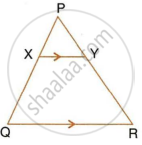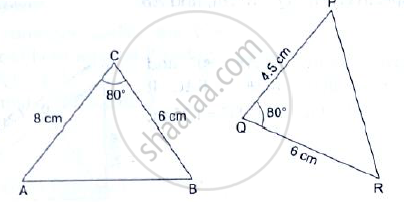Advertisements
Advertisements
प्रश्न
The given figure shows a triangle PQR in which XY is parallel to QR. If PX : XQ = 1 : 3 and QR = 9 cm, find the length of XY.

Further, if the area of ΔPXY = x cm2; find, in terms of x the area of :
- triangle PQR.
- trapezium XQRY.
उत्तर
In ΔPXY and ΔPQR, XY is parallel to QR, so corresponding angles are equal.
∠PXY = ∠PQR
∠PYX = ∠PRQ
Hence, ΔPXY ∼ ΔPQR ...(By AA similarity criterion)
`(PX)/(PQ) = (XY)/(QR)`
`=> 1/4 = (XY)/(QR)` ...(PX : XQ = 1 : 3 `=>` PX : PQ = 1 : 4)
`=> 1/4 = (XY)/(9)`
`=>` XY = 2.25 cm
i. We know that the ratio of areas of two similar triangles is equal to the ratio of the squares of their corresponding sides.
`(Ar(ΔPXY))/(Ar(ΔPQR)) = ((PX)/(PQ))^2 `
`x/(Ar(ΔPQR)) = (1/4)^2 = 1/16`
Ar (ΔPQR) = 16x cm2
ii. Ar (trapezium XQRY) = Ar (ΔPQR) – Ar (ΔPXY)
= (16x – x) cm2
= 15x cm2
APPEARS IN
संबंधित प्रश्न
In figure, ∠CAB = 90º and AD ⊥ BC. If AC = 75 cm, AB = 1 m and BD = 1.25 m, find AD.
A vertical stick 20 cm long casts a shadow 6 cm long on the ground. At the same time, a tower casts a shadow 15 m long on the ground. Find the height of the tower.
In the following figure, seg DH ⊥ seg EF and seg GK ⊥ seg EF. If DH = 18 cm, GK = 30 cm and `A(triangle DEF) = 450 cm^2`, then find:
1) EF
2) `A(triangle GFE)`
3) `A(square DFGE)`

In each of the given pairs of triangles, find which pair of triangles are similar. State the similarity criterion and write the similarity relation in symbolic form:

ΔABC~ΔDEF and their areas are respectively 64 cm2 and 121cm2. If EF = 15.4cm, find BC.
In Δ ABC, DE || BC; DC and EB intersects at F. if `"DE"/"BC" = 2/7` , find `("Ar" (triangle "FDE"))/("Ar" (triangle "FBC"))`
A triangle ABC has been enlarged by scale factor m = 2.5 to the triangle A' B' C'. Calculate : the length of C' A' if CA = 4 cm.
ΔABC is enlarged, with a scale factor 5. Find: BC, f B'C' = 16cm
A plot of land of area 20km2 is represented on the map with a scale factor of 1:200000. Find: The area on the map that represented the plot of land.
In ∆LMN, ∠L = 60°, ∠M = 50°. If ∆LMN ~ ∆PQR then the value of ∠R is
